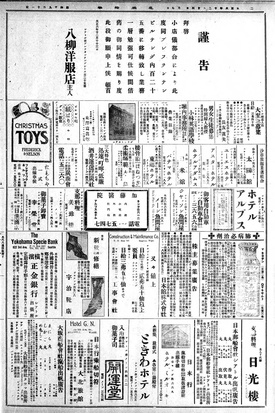
A place for sharing information is essential in the formation of immigrant communities. Even today, various media outlets continue to serve as a place to disseminate information and support the community. In the early 20th century, when Seattle's Japanese community was formed, Japanese-language newspapers boasted a major presence as the only information source for Japanese immigrants.
The Seattle Japanese community experienced great growth around 1900, with the opening of new shipping routes by Nippon Yusen Kaisha and the relocation of the consulate from Tacoma. In response to the community's growth, a number of Japanese-language newspapers and magazines were launched in the late 1890s. The largest of these was the North American Newspaper. It had bureaus not only in the Puget Sound area, but also in Japanese communities in the Northwest, such as Yakima and Spokane, and continued to report on activities in each region.
According to Arima Sumita's book "100 Years of Seattle Daily Japanese Newspapers," North American Jiji was praised as a "high-minded newspaper" and a "serious newspaper that is not gossip-oriented." Some of its staff members were well-known, such as Kiyosawa Ryo, who was active as a foreign affairs commentator before World War II and gained experience as a journalist in the Tacoma branch.
First published on September 1, 1902, it was the third Japanese-language daily paper in the United States, and was published by Kiyoshi Kumamoto and other investors, with the company located in what is now Seattle Japan Town. When it was first published it was six pages long, but in 1905 it was increased to eight pages. By the New Year's issue the following year it had grown to 32 pages and a circulation of 5,000 copies. In 1913, the Arima family, who were the core of the paper's publication, took over management. It had correspondents in Portland, Los Angeles, San Francisco, Spokane, Vancouver, and Tokyo, and a print run of 6,000. In 1918 it began publishing an English-language version, and continued to be published for a long time.

By the time Japan-US relations had become even more strained during World War II, many of the Arima family chose to return to Japan. Arima Sumio, who remained in the US, served as publisher, but was arrested by the FBI when war broke out between Japan and the US. Meanwhile, having lost its leader, North American Jiji Newspaper's employees joined forces to continue publishing articles in the tense Japanese community. Perhaps there was censorship at the time, as the English page was moved to the front page, with the Japanese page beginning on page two. Below the Japanese page is a company announcement calling for support in order to continue publishing the paper.
Publication ceased on March 14, 1942. For 39 and a half years, the newspaper published 12,278 issues as a central presence in the turbulent Japanese immigrant community. According to The Seattle Times at the time, the newspaper had a print run of 9,000 copies, exceeding the Japanese population of the Seattle area. The company had about 50 employees, including some of the core staff members who were part of the founding of the North American Post, a newspaper that was born out of the revitalization of the community after World War II.
North American Current Affairs is available on microfilm at the University of Washington's Suzzallo Library, or through an online archive created as a joint project between the university and the North American Bulletin Foundation.
(Titles omitted)
*This article is reprinted from Seattle lifestyle information magazine Soy Source (May 26, 2017).
© 2017 Sou Source / Shihou Sasaki


